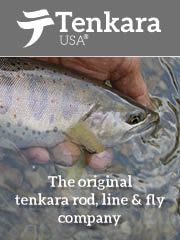I was introduced to this simple pattern in Grand Lake Stream, Maine. In the Pine Tree General Store, next to the cash register in a plastic cup, was a half a dozen of these flies. The gal at the counter informed me that the local landlocked salmon population went crazy over this fly. I was skeptical to say the least, but I wanted to be polite so I snatched up three and added them to my small pile of Barnes Specials and other traditional New England feather winged streamers I picked from their fly bins.
Throughout the week, every time I opened my fly box to select another streamer, this goofy little fly caught my attention. It was so unlike the other streamer patterns that had proven themselves on this stream. The more I looked at this fly, the more I felt I was duped by the young lady at the cash register. No worries, I could always use them back home to catch bluegills.
One afternoon, the landlocked salmon developed a severe case of lock jaw. Nothing I threw at them would elicit a strike. When I opened my streamer box for the umpteenth time that day, the golden retriever fell out. I managed to snatch it out of the air before it hit the water. With the fly now in my hand I figured “what the hell”, so I tied it on. Once the fly was wet, the first thing I noticed was the red underbody that shining through the golden yellow Estaz body. This went un-noticed when I first purchased the flies. The fly definitely had a different look when it was wet. I was intrigued.
Within a few casts I was tight to a scrappy 17” salmon. Then another and another… What started as a pretty crappy afternoon of fishing turned into one of my best days on the river. This versatile fly caught fish dead drifted or retrieved, fished like a nymph or a streamer. I found it performed best when fished like a streamer with an active retrieve. However, I caught fish dead drifting the pattern as well.
By the day's end, I had lost two flies and the last one, still tied to my leader, was a shell of its former self. On the way back to the cabin I stopped by the General Store just as they were closing, but to my dismay the little plastic cup by the cash register was empty. I took the battered fly back to the cabin and carefully dissected it. The fly could not be easier to tie. Hook, lead under body, gold bead, marabou tail, red thread and Estaz, thats it!
When I returned home I quickly tied up a dozen for my next trip up north. Not wanting to wait until my next trip to Maine I used them on my local waters. Trout ate them up and many a farm pond crappie fell to its charms. When I tried to research the origins of the fly I was not surprised to learn that it appears to have been developed by several different tiers in different parts of the country but most sources point to a tier by the name of Jim Finn. The pattern is also tied with other colors of Estaz including white, pink, peach, and root beer, but the red thread remains the same.
 |
| The Golden Retriever |
The Golden Retriever
The Pattern: UV Peach Version
Hook: 3x long streamer size 8 or 10
Bead: Gold brass or tungsten sized to hook
Underbody: .020 or .025 lead wire
Tail: Ginger marabou
Body: 210 denier waxed red UTC thread
“Hackle”: UV Peach Estaz palmered over thread body with a 1/8 inch gap so the red underbody shines through.



















